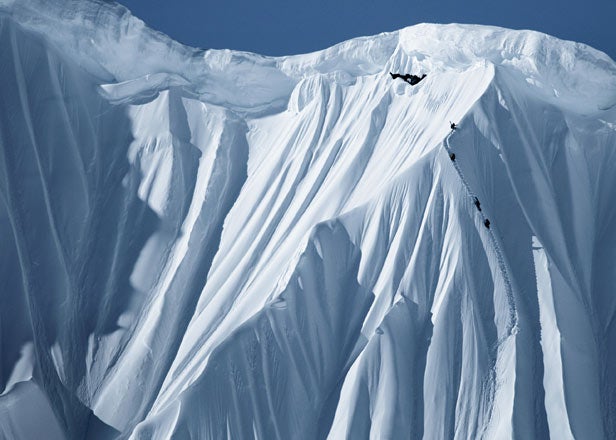IT'S AN EARLY MORNING in June, and Matterhorn Peak rises in front of Jeremy Jones's Ford Focus as we speed through the Sierra Nevada. “You ever read The Dharma Bums?” Jones asks from the driver's seat, adding that Kerouac visited the 12,264-foot California peak in 1955 to explore the relationship between mountaineering and spiritual awareness.
You don't usually expect to talk literature with a professional snowboarder, but Jones is no halfpipe punk. A circumspect 35-year-old who plays chess and paints, he is the world's foremost big-mountain rider, and over the past few years he's made a series of career moves that may well change popular notions of what a snowboarder can accomplish. In 2007, he launched an environmental nonprofit, Protect Our Winters (POW), which seeks to slow climate change—and thus safeguard powder days—through educational initiatives and grants for alternative-energy projects. In 2009, he ended a 19-year sponsorship with Rossignol to start his own company, Jones Snowboards, which has just released a line of Forest Stewardship Council–certified freeride decks. And early last year he swore off helicopters and snowcats, essential tools for any pro trying to drop backcountry peaks in places like Alaska and the Andes.
That last choice might seem insignificant—wanting to “earn your turns” is hardly new—but it's a curious stance for an athlete who made his name by choppering up and then charging down big mountains. It's like Laird Hamilton giving up his jet ski. It's also the kind of commitment that could make Jones the Yvon Chouinard of snowboarding, respected as much for his adventure cred as his personal ethos. Jones's latest film with Teton Gravity Research, Deeper, has him leading top riders up remote slopes on treks that feel more like mountaineering expeditions than snow-porn outings.
“I want to get back to the roots of it all—get dirty again,” says Jones, who slept in his car and subsisted on PB&J early in his career and these days sports a wild mane and scruffy beard. “I don't need sushi waiting for me when I get off the helicopter and dinner with some pompous …” He catches himself there, while steering us toward 13,053-foot Mount Dana, where we're planning to hike up and ride a glaciated couloir. Then he adds, “I've met great people along the way.”
A former racer, Jones began freeriding full-time after failing to make the 1998 U.S. Olympic team. Ever since, he's pulled off perilous descents on heli-missions all over the world, appearing in more than 45 movies, many by TGR, the production company co-founded by his brothers, Steve and Todd, in 1995.
“If he retired tomorrow, his place in snowboarding is guaranteed,” says Pat Bridges, editor of Snowboarder, where Jones has been voted Big Mountain Rider of the Year eight times by his peers. “He's done more for that genre of riding than anybody.”
But after a decade of first descents, Jones was burned out. “When I first went to Alaska, every day was the best of my life,” he tells me. “I'd get home and I'd be bouncing off walls. But it started to go away. It took so much for me to get that buzz that I needed to ride the most dangerous shit out there.”
At the same time, Jones was developing an environmental consciousness like so many others in the great green wake of An Inconvenient Truth. He started thinking about his abundant use of helicopters and snowcats and snowmobiles—and noticing melting glaciers in the mountains. He wanted to do something but hoped to play a supporting role. “I was like, 'Where do I send my check?” he says. He founded POW after a friend convinced him he had an opportunity to leverage his star power. Despite the group's success—they've signed on 10,000-plus members and Jones recently spoke to Congress about the need for climate-change legislation—he remains a reluctant hero, fretting about his lack of education (he never went to college) and the ingrained habits of his profession. (“We've all been gluttonous heli-patrons,” concedes brother Steve.)
Jeremy's status as a green icon should grow with the launch of his brand and the release of Deeper. His boards, which start at $400, are built by by Nidecker Snowboards, a Swiss company with a commitment to low-impact manufacturing. They have wood cores cut from sustainably managed forests, paper-film topsheets that eliminate a pound of plastic per board, and base materials made in part from reclaimed old boards.
The idea behind Deeper was kickstarted in 2008 when Jones hiked a couloir in the Sierra for another film shoot. The descent “paled in comparison to Alaska,” he says, but the slog up completely altered his take on the experience: “I got down and began screaming.” Here he was having fun again—and without the need for a gas-guzzling lift up the mountain. “You've been drooling over this sparkling line all morning on the climb,” he explains. “You're peaking on endorphins, then you chase those with adrenaline. It's the ultimate cocktail.”
Deeper features an all-star cast, including Travis Rice, Xavier de Le Rue, Jonaven Moore, Josh Dirksen, and Tom Burt, plus something you don't see in snowboard films: lots of hiking and climbing. On three continents, the riders ascend peaks on foot or splitboard—a snowboard that can be separated into ski-like lengths for skinning up a slope—sometimes starting up at 2 A.M. Jones had to spend more than 50 nights camping in the backcountry.
Jones, ever the cautious crusader, hastens to clarify that Deeper “is not an an environmental film. We're not trying to push environmental messages.”
Like most athletes, Jones is happiest making his point with actions, which is why he invited me to join him on Mount Dana, the second-highest peak in Yosemite National Park. “The climb is going to kick your ass,” he promised when I arrived at the modest Truckee, California, home he shares with his wife, Tiffany, and two kids, Mia and Cass.
He was right. Four hours after setting out, I catch up with Jones at the summit. We strap in and link turns down summer corn, then follow a stream back to the car. “That was a great day,” Jones says, beaming.
I'm feeling transformed, too. It's a prevailing sense of peace and satisfaction, something like a runner's high.
“That high is what I'm looking for,” says Jones. “Searching for it has been the catalyst for everything.”


